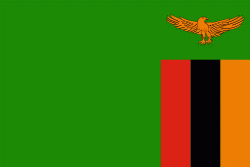Livingstone Memorial (Livingstone Memorial)
The Livingstone Memorial, built in 1899, marks the spot where missionary explorer David Livingstone died on 1 May 1873, in Chief Chitambo's village at Chipundu (today in Chitambo District), near the edge of the Bangweulu Swamps in Zambia. His body was embalmed and his heart was buried there under a mpundu tree by his followers, now led by his loyal attendants Chuma and Susi, who then departed for the coast carrying his body. In their party was an Indian-educated African man named Jacob Wainwright who carved the inscription "LIVINGSTONE MAY 4 1873" and the names of the attendants on the tree.
By 1899, Chitambo's village had dispersed to another site after the death of the chief, and the tree was decaying. It was cut down by Robert Codrington who had been sent by the British Commissioner Alfred Sharpe to prepare the way for a permanent memorial. He made a clearing in the forest and had the carving removed and sent to the Royal Geographical Society's museum in London.
By 1899, Chitambo's village had dispersed to another site after the death of the chief, and the tree was decaying. It was cut down by Robert Codrington who had been sent by the British Commissioner Alfred Sharpe to prepare the way for a permanent memorial. He made a clearing in the forest and had the carving removed and sent to the Royal Geographical Society's museum in London.
Map - Livingstone Memorial (Livingstone Memorial)
Map
Country - Zambia
 |
 |
| Flag of Zambia | |
The region was affected by the Bantu expansion of the 13th century. Following the arrival of European explorers in the 18th century, the British colonised the region into the British protectorates of Barotseland-North-Western Rhodesia and North-Eastern Rhodesia comprising 73 tribes, towards the end of the 19th century. These were merged in 1911 to form Northern Rhodesia. For most of the colonial period, Zambia was governed by an administration appointed from London with the advice of the British South Africa Company. On 24 October 1964, Zambia became independent of the United Kingdom and prime minister Kenneth Kaunda became the inaugural president. From 1972 to 1991 Zambia was a one-party state with the United National Independence Party as the sole legal political party under the motto "One Zambia, One Nation" coined by Kaunda. Kaunda was succeeded by Frederick Chiluba of the social-democratic Movement for Multi-Party Democracy in 1991, beginning a period of government decentralisation.
Currency / Language
| ISO | Currency | Symbol | Significant figures |
|---|---|---|---|
| ZMW | Zambian kwacha | ZK | 2 |
| ISO | Language |
|---|---|
| NY | Chichewa language |
| EN | English language |















